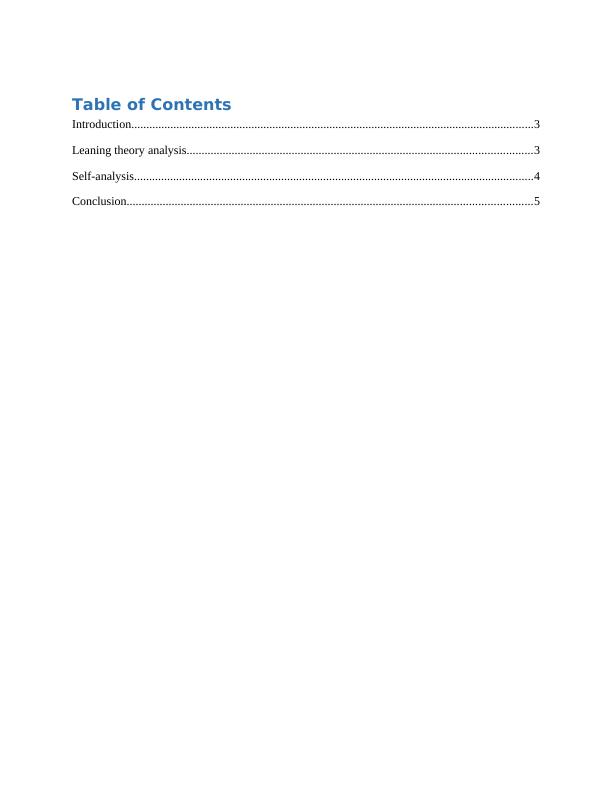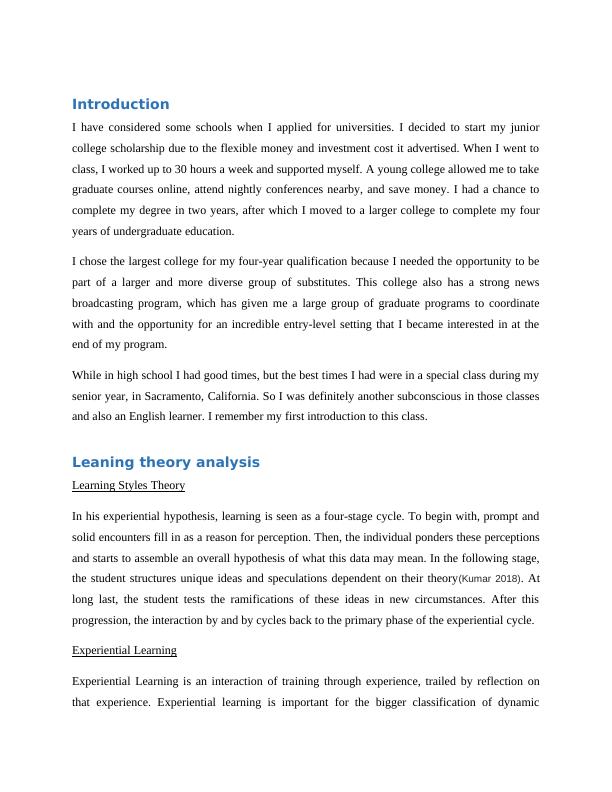Learning Theory Analysis
Added on 2022-12-19
6 Pages1005 Words75 Views
Report

Table of Contents
Introduction......................................................................................................................................3
Leaning theory analysis...................................................................................................................3
Self-analysis.....................................................................................................................................4
Conclusion.......................................................................................................................................5
Introduction......................................................................................................................................3
Leaning theory analysis...................................................................................................................3
Self-analysis.....................................................................................................................................4
Conclusion.......................................................................................................................................5

Introduction
I have considered some schools when I applied for universities. I decided to start my junior
college scholarship due to the flexible money and investment cost it advertised. When I went to
class, I worked up to 30 hours a week and supported myself. A young college allowed me to take
graduate courses online, attend nightly conferences nearby, and save money. I had a chance to
complete my degree in two years, after which I moved to a larger college to complete my four
years of undergraduate education.
I chose the largest college for my four-year qualification because I needed the opportunity to be
part of a larger and more diverse group of substitutes. This college also has a strong news
broadcasting program, which has given me a large group of graduate programs to coordinate
with and the opportunity for an incredible entry-level setting that I became interested in at the
end of my program.
While in high school I had good times, but the best times I had were in a special class during my
senior year, in Sacramento, California. So I was definitely another subconscious in those classes
and also an English learner. I remember my first introduction to this class.
Leaning theory analysis
Learning Styles Theory
In his experiential hypothesis, learning is seen as a four-stage cycle. To begin with, prompt and
solid encounters fill in as a reason for perception. Then, the individual ponders these perceptions
and starts to assemble an overall hypothesis of what this data may mean. In the following stage,
the student structures unique ideas and speculations dependent on their theory(Kumar 2018). At
long last, the student tests the ramifications of these ideas in new circumstances. After this
progression, the interaction by and by cycles back to the primary phase of the experiential cycle.
Experiential Learning
Experiential Learning is an interaction of training through experience, trailed by reflection on
that experience. Experiential learning is important for the bigger classification of dynamic
I have considered some schools when I applied for universities. I decided to start my junior
college scholarship due to the flexible money and investment cost it advertised. When I went to
class, I worked up to 30 hours a week and supported myself. A young college allowed me to take
graduate courses online, attend nightly conferences nearby, and save money. I had a chance to
complete my degree in two years, after which I moved to a larger college to complete my four
years of undergraduate education.
I chose the largest college for my four-year qualification because I needed the opportunity to be
part of a larger and more diverse group of substitutes. This college also has a strong news
broadcasting program, which has given me a large group of graduate programs to coordinate
with and the opportunity for an incredible entry-level setting that I became interested in at the
end of my program.
While in high school I had good times, but the best times I had were in a special class during my
senior year, in Sacramento, California. So I was definitely another subconscious in those classes
and also an English learner. I remember my first introduction to this class.
Leaning theory analysis
Learning Styles Theory
In his experiential hypothesis, learning is seen as a four-stage cycle. To begin with, prompt and
solid encounters fill in as a reason for perception. Then, the individual ponders these perceptions
and starts to assemble an overall hypothesis of what this data may mean. In the following stage,
the student structures unique ideas and speculations dependent on their theory(Kumar 2018). At
long last, the student tests the ramifications of these ideas in new circumstances. After this
progression, the interaction by and by cycles back to the primary phase of the experiential cycle.
Experiential Learning
Experiential Learning is an interaction of training through experience, trailed by reflection on
that experience. Experiential learning is important for the bigger classification of dynamic

End of preview
Want to access all the pages? Upload your documents or become a member.
Related Documents
Leaning Theory Analysislg...
|5
|875
|46
Understanding Student Attendance in Business Schools: An Exploratory Studylg...
|5
|908
|94